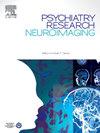Occipital structure is linked to vagal tone in borderline personality but not in major depressive disorder
IF 2.1
4区 医学
Q3 CLINICAL NEUROLOGY
引用次数: 0
Abstract
Major depressive (MDD) and borderline personality disorders (BPD) are highly prevalent and frequently comorbid psychiatric conditions, both characterized by emotion dysregulation yet likely arising from distinct etiologies. Nonetheless, the specific features of autonomic central-peripheral relationships in these disorders remain poorly understood. We investigated the association between brain structure and vagal activity, and explored the resting-state functional connectivity of brain regions found to be associated with vagal tone, in 19 MDD, 18 BPD and 20 healthy controls (HC). We found that the cortical thinning in the right lateral occipital region was associated with increased parasympathetic tone in BPD, a relationship not observed in MDD. Moreover, in BPD, this region was functionally connected to the anterior insula and prefrontal areas, linked to the central autonomic system and emotion regulation processes. Accordingly, this region was also linked to emotion dysregulation in BPD. Our findings highlight distinct central–peripheral autonomic integration in these disorders and emphasize the occipital region's structural and functional involvement in emotional and autonomic regulation in BPD. Further research is needed to clarify how occipital structure and function, well as vagal activity, may contribute as potential biomarkers for BPD.
枕骨结构与边缘型人格的迷走神经张力有关,而与重度抑郁症无关
重度抑郁症(MDD)和边缘型人格障碍(BPD)是非常普遍且经常并存的精神疾病,两者都以情绪失调为特征,但可能由不同的病因引起。尽管如此,这些疾病中自主神经中枢-外周关系的具体特征仍然知之甚少。我们研究了19名MDD、18名BPD和20名健康对照(HC)的大脑结构与迷走神经活动之间的关系,并探索了与迷走神经张力相关的大脑区域的静息状态功能连通性。我们发现右侧枕外侧皮质变薄与BPD副交感神经张力增加有关,而在MDD中没有观察到这种关系。此外,在BPD中,该区域在功能上与前脑岛和前额叶区相连,与中央自主神经系统和情绪调节过程相连。因此,该区域也与BPD的情绪失调有关。我们的研究结果强调了这些疾病中明显的中枢-外周自主神经整合,并强调了枕区在BPD中参与情绪和自主神经调节的结构和功能。枕部结构和功能以及迷走神经活动如何可能作为BPD的潜在生物标志物,还需要进一步的研究来阐明。
本文章由计算机程序翻译,如有差异,请以英文原文为准。
求助全文
约1分钟内获得全文
求助全文
来源期刊
CiteScore
3.80
自引率
0.00%
发文量
86
审稿时长
22.5 weeks
期刊介绍:
The Neuroimaging section of Psychiatry Research publishes manuscripts on positron emission tomography, magnetic resonance imaging, computerized electroencephalographic topography, regional cerebral blood flow, computed tomography, magnetoencephalography, autoradiography, post-mortem regional analyses, and other imaging techniques. Reports concerning results in psychiatric disorders, dementias, and the effects of behaviorial tasks and pharmacological treatments are featured. We also invite manuscripts on the methods of obtaining images and computer processing of the images themselves. Selected case reports are also published.

 求助内容:
求助内容: 应助结果提醒方式:
应助结果提醒方式:


